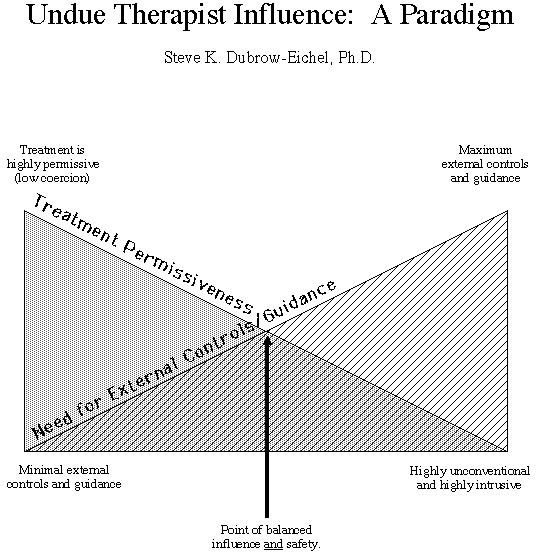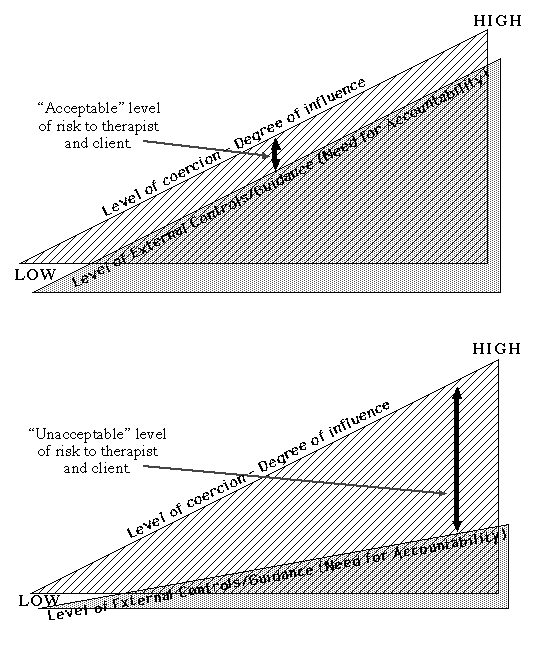

Undue Therapist Influence: A Paradigm
Steve K. D. Eichel, Ph.D.
Medical ethics
All things being equal (or all things considered), always favor the less intrusive approach.The more intrusive the treatment, the more the need for:
External controls.External validation of the treatment's effectiveness.
Therapist compliance with scientifically-validated treatment guidelines.
General rule
The more intensive and intrusive the therapy, the stronger the likelihood of abuse.The more intensive and intrusive the therapy, the more we need external controls.
Conscious and unconscious motivations that might contribute to abuse
Material gainSexual conquest
Desire to validate one's own memories of abuse
Desire for professional fame and power
Modalities of abuse
Con-artist tactics (the therapist has strong sociopathic tendencies and is not primarily concerned with client wellbeing).Well-intended abuses of power: Therapeutic Techniques that can become exploitive.
Transference intensification methods.Prolonged sessions.Intensive therapy (e.g., analysis).
Encouragement of dependence.
Covert and overt sexualization.
Hypnosis and hypnoidal methods: A new hypnosis model suggested by Theodore X. Barber may account for the ease with which some clients have trance experiences even without formal hypnosis.
Hypnotherapy, especially by relatively untrained or poorly trained therapists.Guided imagery.
Regression therapy.
Social Demand methods
Group therapyRole-playing
Milieu therapy
Dimensions
Treatment PermissivenessHighly permissiveDecreased pervasivenessTarget is specific behavior, not underlying personality, change.Focus is on current life, not childhood.
Minimal attempts by therapist to direct client's behaviors outside therapy hour.
Minimal interpretation of client's world by therapist.
Decreased influence
Highly client-centeredPermissive techniques only
(3Minimal use of overt or covert pressure.
Minimal interpretation of client's world by therapist.
Decreased intrusiveness
Minimal confrontation; "soft" confrontation.Minimal direction of affect experience and expression.
Minimal attempts by therapist to direct people within client's sphere of social interaction.
Minimal attempts by therapist to influence client's decision-making process.
Decreased regression and dependency.
Minimal attempts to initiate client regression.Minimal attempts to facilitate dependency.
Highly coercive
Increased pervasivenessTarget is underlying personality change.Focus is on childhood, especially "forgotten" experiences; high degree of interpretation.
Attempts by therapist to direct client's behaviors outside therapy hour.
Increased influence
Therapist directs treatment agenda.Therapist relies on directive techniques.
Therapist incorporates overt or covert pressure.
Therapist routinely interprets client's world; may encourage radical redefinitions of personal history (at risk for so-called "false memories")
Increased intrusiveness
Targeted "hard" confrontation.Therapist directs client's affect experience and expression.
Therapist attempts to direct people within client's sphere of social interaction.
Therapist attempts to direct client's decision-making process.
Increased regression and dependency.
Therapist deliberately and/or routinely regresses client.Therapist attempts to "reparent" client.
Suggestions for therapist working at various points along the continuums (Permissiveness vs. Coercion; Minimal vs. Maximum External Control).
Therapy is highly permissive.Supervision/consultation can be informal and on as-needed basis.Therapy involves moderate degree of influence and directiveness.
Ongoing, regular supervision/consultation.Therapist makes certain to keep abreast of research, including research critical of therapy approach.
Therapist engages in own therapy (focus on counter-transference) on as-needed basis.
Therapy is highly coercive.
Ongoing, regular supervision/consultation, preferably with a highly skilled, mature therapist not connected with agency or practice.Therapist is engaged in own therapy with a highly skilled, mature therapist not connected with agency or practice.
Agency or program is routinely evaluated by outside credentialing body.
Therapist routinely and continuously exposes him/herself to research, including research critical of therapy approach.


|
|
|
|
|
|
|
|